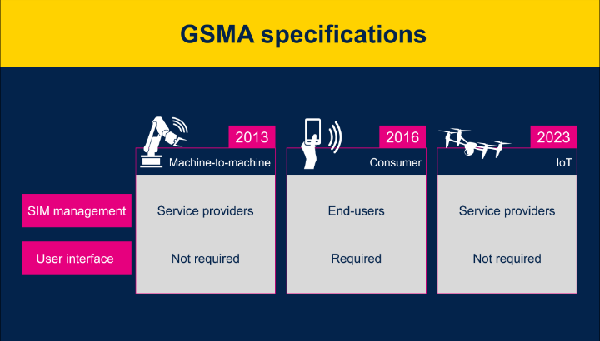
The summer brought some exciting news for IoT developers. The integration of eSIM cards into IoT devices can now be streamlined with GSMA’s new framework for IoT. Naturally, ST is upgrading its portfolio, with a new wave of products coming in 2024. In this article, we will explore how GSMA eSIMs can enhance agility and efficiency in IoT projects.
Let’s start with the basics. What is an eSIM?
Based on a secure microcontroller, an embedded Subscriber Identity Module (eSIM) is no less than a tiny computer that manages encryption keys and stores confidential information to securely identify devices and authenticate users. Embedded SIMs offer developers three important advantages over regular SIMs. First, eSIMs aren’t removable, they are directly soldered into devices which helps free up valuable space on PCB—a good omen for batteries. Their size is four to fifteen times smaller, making them ideal for IoT and wearable devices. To take one small example, ST’s most recent eSIM has a footprint of 7 mm2. Second, eSIMs are more robust. They can be used in industrial environments for machine-to-machine communications, as well as in Automotive applications (Vehicle-to-everything systems, etc). Third point, eSIMs have the potential to bring more freedom to the end users. Disappointingly, a potential that goes unfulfilled. Although eSIMs can technically support multiple telecom operator profiles, users are still not allowed to juggle between plans. All that is about to change though.
GSMA eSIMs for IoT: the freedom of choice
In 2025, we will be surrounded by 30.9 billion connected IoT devices1. Some of these devices are designed to make our lives easier, others to ensure our safety and protect our health. Hence, IoT developers need to ensure the best connectivity anywhere at any time, in an affordable way.
So, what’s new with this specification? A major benefit: easy and quick subscriptions. Users can subscribe to multiple international plans and switch between them in record time, depending on their needs or location. Each profile represents a different mobile plan. Plans from various international operators can be activated or deactivated via over-the-air updates instantly. All this without human intervention.
What does this mean for developers? They can now create IoT solutions that automatically switch to the best available network to maximize network performance and cost savings. Take, as an example, asset tracking. With the next wave of GSMA-certified eSIMs, roaming fees can be eliminated. And latencies will come down considerably.
Reducing the complexity of your IoT project: from design to production
Forget everything you’ve heard about development complexity. To update eSIMs remotely, the previous GSMA specification (designed for machine-to-machine) required the use of a certified Subscription Manager Secure Routing (SM-SR) server, which was pre-integrated with certified Subscription Manager Data Preparation (SM-DP) servers. A bane for many IoT developers that design ultralow power devices, with no or limited user interfaces. But here is the good news. This new specification doesn’t require such a complex configuration. This fundamental change simplifies the swapping process with instant updates.

Additionally, future GSMA-certified eSIMs will work with the vast majority of IoT devices that do not have the processing power or user interface of a typical smartphone or tablet. And eSIMs will be capable of supporting a diverse range of network constraints, including LPWAN (Low Power Wide Area Network) technologies such as NB-IoT (Narrowband IoT).
To the best of our knowledge, ST is the world’s only one-stop eSIM shop for Industrial & IoT. Developers can save both time and money with ST’s comprehensive offer, which includes everything from silicon components to operating system development and product personalization—we can even load your sensitive data for you, using ST’s certified manufacturing process.
To sum things up, future GSMA-certified eSIMs will be a key enabler toward the development and democratization of next gen. IoT devices. Our next gen. GSMA eSIMs products will be released in 2024. Contact our sales team to receive samples!






